by Calculated Risk on 10/03/2022 11:13:00 AM
Monday, October 03, 2022
Black Knight Mortgage Monitor: "Home Prices Down Again in August ... Now 2% Off June Peak"
Today, in the Calculated Risk Real Estate Newsletter: Black Knight Mortgage Monitor: "Home Prices Down Again in August ... Now 2% Off June Peak"
A brief excerpt:
Here is a graph of the Black Knight HPI. The index is still up 12.1% year-over-year but was down almost 1% in August (after a similar decline in July).There is much more in the article. You can subscribe at https://calculatedrisk.substack.com/
• According to the Black Knight HPI, median home prices fell 0.98% in August, only marginally better than July's upwardly revised 1.05% monthly decline
• July and August 2022 mark the largest single-month price declines seen since January 2009 and rank among the eight largest on record
• The housing market has not seen such a significant two-month drop in prices since shortly after the collapse of Lehman Brothers in the winter of 2008
Construction Spending Decreased 0.7% in August
by Calculated Risk on 10/03/2022 10:19:00 AM
From the Census Bureau reported that overall construction spending increased:
Construction spending during August 2022 was estimated at a seasonally adjusted annual rate of $1,781.3 billion, 0.7 percent below the revised July estimate of $1,793.5 billion. The August figure is 8.5 percent above the August 2021 estimate of $1,641.6 billion.Both private spending and public spending decreased:
emphasis added
Spending on private construction was at a seasonally adjusted annual rate of $1,426.0 billion, 0.6 percent below the revised July estimate of $1,435.2 billion. ...
In August, the estimated seasonally adjusted annual rate of public construction spending was $355.3 billion, 0.8 percent below the revised July estimate of $358.3 billion.
 Click on graph for larger image.
Click on graph for larger image.This graph shows private residential and nonresidential construction spending, and public spending, since 1993. Note: nominal dollars, not inflation adjusted.
Residential (red) spending is 35% above the bubble peak (in nominal terms - not adjusted for inflation).
Non-residential (blue) spending is 24% above the bubble era peak in January 2008 (nominal dollars).
Public construction spending is 9% above the peak in March 2009.
 The second graph shows the year-over-year change in construction spending.
The second graph shows the year-over-year change in construction spending.On a year-over-year basis, private residential construction spending is up 12.5%. Non-residential spending is up 5.5% year-over-year. Public spending is up 3.3% year-over-year.
ISM® Manufacturing index Declined to 50.9% in September
by Calculated Risk on 10/03/2022 10:05:00 AM
(Posted with permission). The ISM manufacturing index indicated expansion. The PMI® was at 50.9% in September, down from 52.8% in August. The employment index was at 48.7%, down from 54.2% last month, and the new orders index was at 47.1%, down from 51.3%.
From ISM: Manufacturing PMI® at 50.9% September 2022 Manufacturing ISM® Report On Business®
Economic activity in the manufacturing sector grew in September, with the overall economy achieving a 28th consecutive month of growth, say the nation's supply executives in the latest Manufacturing ISM® Report On Business®.This suggests manufacturing expanded at a slower pace in September than in August. This was below the consensus forecast.
The report was issued today by Timothy R. Fiore, CPSM, C.P.M., Chair of the Institute for Supply Management® (ISM®) Manufacturing Business Survey Committee:
“The September Manufacturing PMI® registered 50.9 percent, 1.9 percentage points lower than the 52.8 percent recorded in August. This figure indicates expansion in the overall economy for the 28th month in a row after contraction in April and May 2020. The Manufacturing PMI® figure is the lowest since May 2020, when it registered 43.5 percent. The New Orders Index returned to contraction territory at 47.1 percent, 4.2 percentage points lower than the 51.3 percent recorded in August. The Production Index reading of 50.6 percent is a 0.2-percentage point increase compared to August’s figure of 50.4 percent. The Prices Index registered 51.7 percent, down 0.8 percentage point compared to the August figure of 52.5 percent. This is the index’s lowest reading since June 2020 (51.3 percent). The Backlog of Orders Index registered 50.9 percent, 2.1 percentage points lower than the August reading of 53 percent. After a single month of expansion, the Employment Index contracted at 48.7 percent, 5.5 percentage points lower than the 54.2 percent recorded in August. The Supplier Deliveries Index reading of 52.4 percent is 2.7 percentage points lower than the August figure of 55.1 percent. This is the index’s lowest reading since before the coronavirus pandemic (52.2 percent in December 2019). The Inventories Index registered 55.5 percent, 2.4 percentage points higher than the August reading of 53.1 percent. The New Export Orders Index contracted at 47.8 percent, down 1.6 percentage points compared to August’s figure of 49.4 percent. This is the index’s lowest reading since June 2020, when it registered 47.6 percent. The Imports Index remained in expansion territory at 52.6 percent, 0.1 percentage point above the August reading of 52.5 percent.”
emphasis added
Housing October 3rd Update: Inventory Increased 0.8% Last Week; Hits New Peak for 2022
by Calculated Risk on 10/03/2022 08:49:00 AM
Active inventory increased for the 3rd consecutive week, increasing 0.8% last week, and hitting a new peak for the year. Here are the same week inventory changes for the last four years (usually inventory is declining at this time of year):
 Click on graph for larger image.
Click on graph for larger image.This inventory graph is courtesy of Altos Research.
1. The seasonal bottom (happened on March 4th for Altos) ✅
2. Inventory up year-over-year (happened on May 13th for Altos) ✅
3. Inventory up compared to two years ago (currently down 0.3% according to Altos)
4. Inventory up compared to 2019 (currently down 41.3%).
Four High Frequency Indicators for the Economy
by Calculated Risk on 10/03/2022 08:33:00 AM
These indicators are mostly for travel and entertainment. It is interesting to watch these sectors recover as the pandemic subsides.
The TSA is providing daily travel numbers.
This data is as of October 2nd.
 Click on graph for larger image.
Click on graph for larger image.This data shows the 7-day average of daily total traveler throughput from the TSA for 2019 (Light Blue), 2020 (Black), 2021 (Blue) and 2022 (Red).
The dashed line is the percent of 2019 for the seven-day average.
The 7-day average is down 10.9% from the same day in 2019 (89.1% of 2019). (Dashed line)
 This data shows domestic box office for each week and the median for the years 2016 through 2019 (dashed light blue).
This data shows domestic box office for each week and the median for the years 2016 through 2019 (dashed light blue). Note that the data is usually noisy week-to-week and depends on when blockbusters are released.
Movie ticket sales were at $83 million last week, down about 41% from the median for the week.
 This graph shows the seasonal pattern for the hotel occupancy rate using the four-week average.
This graph shows the seasonal pattern for the hotel occupancy rate using the four-week average. The red line is for 2022, black is 2020, blue is the median, and dashed light blue is for 2021. Dashed purple is 2019 (STR is comparing to a strong year for hotels).
This data is through Sept 24th. The occupancy rate was down 1.5% compared to the same week in 2019.
Notes: Y-axis doesn't start at zero to better show the seasonal change.
Blue is for 2020. Purple is for 2021, and Red is for 2022.
As of September 23rd, gasoline supplied was down 5.6% compared to the same week in 2019.
Recently gasoline supplied has been running below 2019 and 2021 levels - and sometimes below 2020.
Sunday, October 02, 2022
Monday: ISM Mfg, Construction Spending
by Calculated Risk on 10/02/2022 07:42:00 PM
Weekend:
• Schedule for Week of October 2, 2022
Monday:
• At 10:00 AM ET, ISM Manufacturing Index for September. The consensus is for a reading of 52.2, down from 52.8 in August.
• Also, at 10:00 AM, Construction Spending for August. The consensus is for a 0.3% decrease.
From CNBC: Pre-Market Data and Bloomberg futures S&P 500 are down 1 and DOW futures are up 42 (fair value).
Oil prices were up over the last week with WTI futures at $79.49 per barrel and Brent at $85.14 per barrel. A year ago, WTI was at $76, and Brent was at $79 - so WTI oil prices are up 5% year-over-year.
Here is a graph from Gasbuddy.com for nationwide gasoline prices. Nationally prices are at $3.76 per gallon. A year ago, prices were at $3.18 per gallon, so gasoline prices are up $0.58 per gallon year-over-year. NOTE: Gasoline prices in Los Angeles have spiked to near record $6.28 per gallon due to refinery issues.
Update: Framing Lumber Prices Close to Pre-Pandemic Levels
by Calculated Risk on 10/02/2022 12:04:00 PM
Here is another monthly update on framing lumber prices.
This graph shows CME random length framing futures through September 30th.
Prices are close to the pre-pandemic levels of around $400.
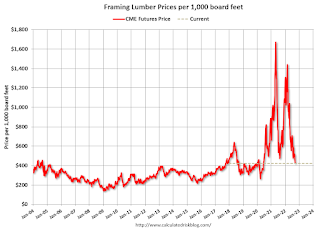 Click on graph for larger image.
Click on graph for larger image.It is unlikely we will see a runup in prices as happened at the end of last year due to the housing slowdown.
Saturday, October 01, 2022
Real Estate Newsletter Articles this Week
by Calculated Risk on 10/01/2022 02:11:00 PM
At the Calculated Risk Real Estate Newsletter this week:
• Goldman Sees US House Prices Falling 5% to 10%
• Case-Shiller: National House Price Index "Continued its Deceleration" to 15.8% year-over-year increase in July
• Inflation Adjusted House Prices Declined Further in July
• New Home Sales Increased in August; Completed Inventory Increased
• Pace of Rent Increases Continues to Slow
• New Home Sales and Cancellations: Net vs Gross Sales
This is usually published 4 to 6 times a week and provides more in-depth analysis of the housing market.
You can subscribe at https://calculatedrisk.substack.com/
Schedule for Week of October 2, 2022
by Calculated Risk on 10/01/2022 08:11:00 AM
The key report this week is the September employment report on Friday.
Other key indicators include the September ISM Manufacturing and Services indices, September auto sales and the August trade deficit.
10:00 AM: ISM Manufacturing Index for September. The consensus is for a reading of 52.2, down from 52.8 in August.
10:00 AM: Construction Spending for August. The consensus is for a 0.3% decrease.
8:00 AM ET: Corelogic House Price index for August.
 10:00 AM: Job Openings and Labor Turnover Survey for August from the BLS.
10:00 AM: Job Openings and Labor Turnover Survey for August from the BLS. This graph shows job openings (black line), hires (purple), Layoff, Discharges and other (red column), and Quits (light blue column) from the JOLTS.
Jobs openings increased in July to 11.239 million from 11.040 million in June.
The number of job openings (yellow) were up 4% year-over-year. Quits were up 2% year-over-year.
 All day: Light vehicle sales for September.
All day: Light vehicle sales for September.The consensus is for sales of 13.5 million SAAR, up from 13.2 million SAAR in August (Seasonally Adjusted Annual Rate).
This graph shows light vehicle sales since the BEA started keeping data in 1967. The dashed line is the current sales rate.
7:00 AM ET: The Mortgage Bankers Association (MBA) will release the results for the mortgage purchase applications index.
8:15 AM: The ADP Employment Report for September. This report is for private payrolls only (no government). The consensus is for 205,000 jobs added, up from 132,000 in August.
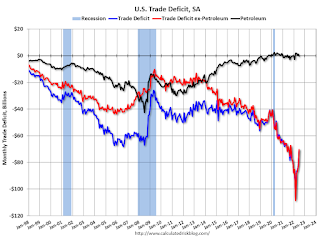 8:30 AM: Trade Balance report for August from the Census Bureau. The consensus is for the deficit to be $68.0 billion in August, from $70.7 billion in July.
8:30 AM: Trade Balance report for August from the Census Bureau. The consensus is for the deficit to be $68.0 billion in August, from $70.7 billion in July.This graph shows the U.S. trade deficit, with and without petroleum, through the most recent report. The blue line is the total deficit, and the black line is the petroleum deficit, and the red line is the trade deficit ex-petroleum products.
10:00 AM: the ISM Services Index for September.
8:30 AM: The initial weekly unemployment claims report will be released. The consensus is for an increase to 203 thousand from 193 thousand last week.
 8:30 AM: Employment Report for September. The consensus is for 250,000 jobs added, and for the unemployment rate to be unchanged at 3.7%.
8:30 AM: Employment Report for September. The consensus is for 250,000 jobs added, and for the unemployment rate to be unchanged at 3.7%.There were 315,000 jobs added in August, and the unemployment rate was at 3.7%.
This graph shows the job losses from the start of the employment recession, in percentage terms.
The current employment recession was by far the worst recession since WWII in percentage terms. However, 30 months after the onset of the current employment recession, all of the jobs have returned.
Friday, September 30, 2022
COVID Sept 30, 2022, Update on Cases, Hospitalizations and Deaths
by Calculated Risk on 9/30/2022 09:14:00 PM
NOTE: Starting next week, COVID stats will be updated only on Fridays.
On COVID (focus on hospitalizations and deaths):
| COVID Metrics | ||||
|---|---|---|---|---|
| Now | Week Ago | Goal | ||
| New Cases per Day2 | 45,725 | 54,205 | ≤5,0001 | |
| Hospitalized2 | 23,052 | 25,159 | ≤3,0001 | |
| Deaths per Day2 | 325 | 376 | ≤501 | |
| 1my goals to stop daily posts, 27-day average for Cases, Currently Hospitalized, and Deaths 🚩 Increasing 7-day average week-over-week for Cases, Hospitalized, and Deaths ✅ Goal met. | ||||
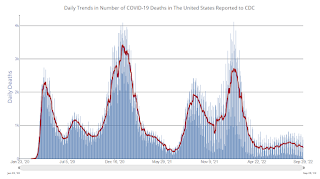 Click on graph for larger image.
Click on graph for larger image.This graph shows the daily (columns) and 7-day average (line) of deaths reported.
Fannie Mae: Mortgage Serious Delinquency Rate Decreased in August
by Calculated Risk on 9/30/2022 04:11:00 PM
Fannie Mae reported that the Single-Family Serious Delinquency decreased to 0.72% in August from 0.76% in July. The serious delinquency rate is down from 1.79% in August 2021. This is almost back to pre-pandemic levels.
These are mortgage loans that are "three monthly payments or more past due or in foreclosure".
The Fannie Mae serious delinquency rate peaked in February 2010 at 5.59% following the housing bubble and peaked at 3.32% in August 2020 during the pandemic.
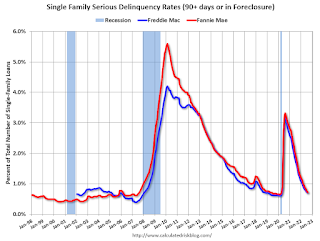
By vintage, for loans made in 2004 or earlier (1% of portfolio), 2.48% are seriously delinquent (down from 2.60% in July).
Mortgages in forbearance were counted as delinquent in this monthly report, but they were not reported to the credit bureaus.
Freddie Mac reported earlier.
Goldman Sees US House Prices Falling 5% to 10%
by Calculated Risk on 9/30/2022 01:47:00 PM
Today, in the Calculated Risk Real Estate Newsletter: Goldman See US House Prices Falling 5% to 10%
Excerpt:
The recent weakness in the housing market, combined with mortgage rates close to 7%, have led to some downwards revisions to house price forecasts. For example, from Goldman Sachs economists today:Our G10 home price model suggests sizable nominal home prices declines from the peak of around 15% in Canada, 5-10% in the US, and under 5% in the UK. … We view the risks to these estimates as tilted to the downsideThis is a significant downgrade from Goldman’s “stall” forecast from just a few weeks ago. ...
emphasis added
It now appears house prices are falling even though inventory levels are still historically fairly low (by measures of active inventory or months of supply). ... Here is a look at existing home months-of-supply (inverted, from the NAR) vs. the seasonally adjusted month-to-month price change in the Case-Shiller National Index (both since January 1999 through July 2022). Note that the months-of-supply is not seasonally adjusted.
The last three months are in black showing a possible shift in the relationship.
Q3 GDP Tracking: 1% to 2% Range
by Calculated Risk on 9/30/2022 01:13:00 PM
From BofA:
Overall, the data since our last weekly publication and our updated assumptions on trade boosted our 3Q US GDP tracking from 0.8% q/q saar to 1.5% q/q saar. [September 30th estimate]From Goldman:
emphasis added
Following this morning’s data and yesterday’s revisions, we have lowered our Q3 GDP tracking forecast by 0.5pp to +0.9% (qoq ar). [September 30th estimate]And from the Altanta Fed: GDPNow
The GDPNow model estimate for real GDP growth (seasonally adjusted annual rate) in the third quarter of 2022 is 2.4 percent on September 30, up from 0.3 percent on September 27. After recent releases from the US Bureau of Economic Analysis and the US Census Bureau, the nowcasts of third-quarter personal consumption expenditures growth and third-quarter gross private domestic investment growth increased from 0.4 percent and -7.6 percent, respectively, to 1.0 percent and -4.2 percent, respectively, while the nowcast of the contribution of net exports to first-quarter real GDP growth increased from 1.10 percentage points to 2.20 percentage points. [September 30th estimate]
Realtor.com Reports Weekly Active Inventory Up 29% Year-over-year; New Listings Down 10%
by Calculated Risk on 9/30/2022 09:48:00 AM
Realtor.com has monthly and weekly data on the existing home market. Here is their weekly report released yesterday from Chief Economist Danielle Hale and Jiayi Xu: Weekly Housing Trends View — Data Week Ending Sep 24, 2022. Note: They have data on list prices, new listings and more, but this focus is on inventory.
• Active inventory continued to grow, and improved 29% above one year ago. Financial conditions are changing the balance of sellers and buyers in the housing market with more homes for-sale compared to one year ago. Still, the market is still not back to pre-pandemic inventory levels.
...
• New listings–a measure of sellers putting homes up for sale–were again down, dropping 10% from one year ago. This week marks the twelfth straight week of year over year declines in the number of new listings coming up for sale.
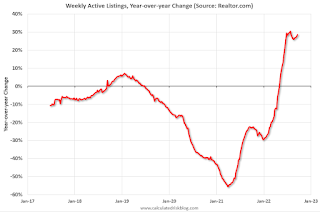 Here is a graph of the year-over-year change in inventory according to realtor.com.
Here is a graph of the year-over-year change in inventory according to realtor.com. Note the rapid increase in the YoY change earlier this year, from down 30% at the beginning of the year, to up 29% YoY at the beginning of July.
Personal Income increased 0.3% in August; Spending increased 0.4%
by Calculated Risk on 9/30/2022 08:39:00 AM
The BEA released the Personal Income and Outlays, August 2022 and Annual Update report:
Personal income increased $71.6 billion (0.3 percent) in August, according to estimates released today by the Bureau of Economic Analysis. Disposable personal income (DPI) increased $67.6 billion (0.4 percent) and personal consumption expenditures (PCE) increased $67.5 billion (0.4 percent).The August PCE price index increased 6.2 percent year-over-year (YoY), down from 6.4 percent YoY in July.
The PCE price index increased 0.3 percent. Excluding food and energy, the PCE price index increased 0.6 percent. Real DPI increased 0.1 percent in August and Real PCE increased 0.1 percent; goods decreased 0.2 percent and services increased 0.2 percent.
emphasis added
The following graph shows real Personal Consumption Expenditures (PCE) through August 2022 (2012 dollars). Note that the y-axis doesn't start at zero to better show the change.
 Click on graph for larger image.
Click on graph for larger image.The dashed red lines are the quarterly levels for real PCE.
Personal income was at expectations, and PCE was above expectations.
Using the two-month method to estimate Q3 real PCE growth, real PCE was increasing at a 0.8% annual rate in Q3 2022. (Using the mid-month method, real PCE was increasing at 0.9%)
Thursday, September 29, 2022
Friday: Personal Income & Outlays, Chicago PMI
by Calculated Risk on 9/29/2022 09:02:00 PM
Friday:
• At 8:30 AM ET, Personal Income and Outlays, August 2022 and Annual Update The consensus is for a 0.3% increase in personal income, and for a 0.2% increase in personal spending. And for the Core PCE price index to increase 0.5%. PCE prices are expected to be up 6.0% YoY, and core PCE prices up 4.8% YoY.
• At 9:45 AM, Chicago Purchasing Managers Index for September. The consensus is for a reading of 52.0, down from 52.2 in August.
• At 10:00 AM, University of Michigan's Consumer sentiment index (Final for September). The consensus is for a reading of 59.5.
On COVID (focus on hospitalizations and deaths):
| COVID Metrics | ||||
|---|---|---|---|---|
| Now | Week Ago | Goal | ||
| New Cases per Day2 | 47,112 | 54,201 | ≤5,0001 | |
| Hospitalized2 | 23,401 | 25,449 | ≤3,0001 | |
| Deaths per Day2 | 343 | 368 | ≤501 | |
| 1my goals to stop daily posts, 27-day average for Cases, Currently Hospitalized, and Deaths 🚩 Increasing 7-day average week-over-week for Cases, Hospitalized, and Deaths ✅ Goal met. | ||||
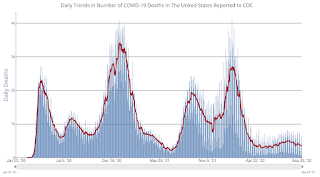 Click on graph for larger image.
Click on graph for larger image.This graph shows the daily (columns) and 7-day average (line) of deaths reported.
Las Vegas August 2022: Visitor Traffic Down 10.9% Compared to 2019
by Calculated Risk on 9/29/2022 02:18:00 PM
Note: I like using Las Vegas as a measure of recovery for both leisure (visitors) and business (conventions).
From the Las Vegas Visitor Authority: August 2022 Las Vegas Visitor Statistics
August visitation reached nearly 3.2M visitors for the month, up +6.4% YoY and ‐10.9% below the August 2019 volume.
Overall hotel occupancy reached 76.8%, +4.0 pts ahead of last August but down ‐10.9 pts vs. August 2019. Surpassing 90% for the sixth straight month, Weekend occupancy reached 90.1% (up +3.0 pts YoY but down ‐5.1 pts vs. August 2019), while Midweek occupancy came in at 72.2% (up +4.4 pts YoY but down ‐11.9 pts vs. August 2019).
The trend of strong ADR continued as August ADR exceeded $148, +5.5% ahead of last August and 22.4% above August 2019 while RevPAR neared $114 for the month, +11.3% YoY and +7.2% over August 2019.
 Click on graph for larger image.
Click on graph for larger image. The first graph shows visitor traffic for 2019 (dark blue), 2020 (light blue), 2021 (yellow) and 2022 (red)
Visitor traffic was down 10.9% compared to the same month in 2019.
Note: There was almost no convention traffic from April 2020 through May 2021.
Hotels: Occupancy Rate Down 1.5% Compared to Same Week in 2019
by Calculated Risk on 9/29/2022 11:51:00 AM
Note: The occupancy rate will increase next week due to Hurricane Ian.
U.S. hotel performance increased from the previous week and showed improved comparisons with 2019, according to STR‘s latest data through Sept. 24.The following graph shows the seasonal pattern for the hotel occupancy rate using the four-week average.
Sept. 18-24, 2022 (percentage change from comparable week in 2019*):
• Occupancy: 70.0% (-1.5%)
• Average daily rate (ADR): $157.99 (+15.7%)
• Revenue per available room (RevPAR): $110.60 (+13.9%)
*Due to the pandemic impact, STR is measuring recovery against comparable time periods from 2019.
emphasis added
 Click on graph for larger image.
Click on graph for larger image.The red line is for 2022, black is 2020, blue is the median, and dashed light blue is for 2021. Dashed purple is 2019 (STR is comparing to a strong year for hotels).
Inflation Adjusted House Prices Declined Further in July
by Calculated Risk on 9/29/2022 09:34:00 AM
Today, in the Calculated Risk Real Estate Newsletter: Inflation Adjusted House Prices Declined Further in July
Excerpt:
It has been over 16 years since the bubble peak. In the Case-Shiller release Tuesday, the seasonally adjusted National Index (SA), was reported as being 65% above the bubble peak in 2006. However, in real terms, the National index (SA) is about 15% above the bubble peak (and historically there has been an upward slope to real house prices). The composite 20, in real terms, is about 6% above the bubble peak.
People usually graph nominal house prices, but it is also important to look at prices in real terms (inflation adjusted). As an example, if a house price was $200,000 in January 2000, the price would be almost $338,000 today adjusted for inflation (69% increase). That is why the second graph below is important - this shows "real" prices (adjusted for inflation). ...
The second graph shows the same two indexes in real terms (adjusted for inflation using CPI less Shelter). Note: some people use other inflation measures to adjust for real prices. In real terms, the National index is 14.6% above the bubble peak, and the Composite 20 index is 5.6% above the bubble peak in early 2006.
This is the second consecutive month with declining real prices.
Weekly Initial Unemployment Claims decrease to 193,000
by Calculated Risk on 9/29/2022 08:39:00 AM
The DOL reported:
In the week ending September 24, the advance figure for seasonally adjusted initial claims was 193,000, a decrease of 16,000 from the previous week's revised level. The previous week's level was revised down by 4,000 from 213,000 to 209,000. The 4-week moving average was 207,000, a decrease of 8,750 from the previous week's revised average. The previous week's average was revised down by 1,000 from 216,750 to 215,750.The following graph shows the 4-week moving average of weekly claims since 1971.
emphasis added
 Click on graph for larger image.
Click on graph for larger image.The dashed line on the graph is the current 4-week average. The four-week average of weekly unemployment claims decreased to 207,000.
The previous week was revised down.
Weekly claims were lower than the consensus forecast.






